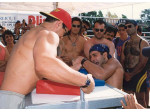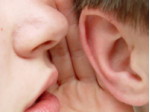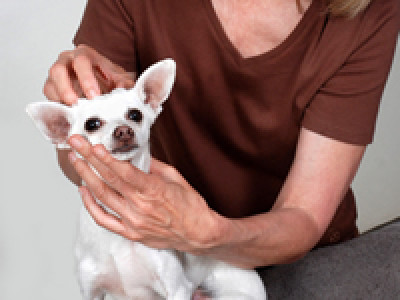Shopping Cart:
0 item(s) - NZ$0.00Pet Massage for our Distressed Furry Friends
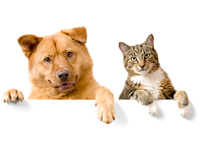 For nearly two decades I have worked in deep tissue massage treating thousands of people for injury and assisted them in resolving often deep emotional issues and trauma.
For nearly two decades I have worked in deep tissue massage treating thousands of people for injury and assisted them in resolving often deep emotional issues and trauma.
As well as that, over the years I’ve performed deep tissue massage on all sorts of animals. From dogs in refuges with displaysure and depression, as well as dogs and cats with bad attitudes (two come to mind nicknamed respectively Devil and Satan), plus horses, llamas, even tiger cubs.
Friends will often gently suggest (ask) that I do a bit of deep tissue massage on an injured pet, such as older dogs that still think they’re puppies and overdo a morning in the park, or hyper dogs that won’t stop barking and jumping up on people and I love doing it.
Occasionally however, I get the chance to really a change an animal’s life. It’s such a pleasure to do when you know how and I figured it’s way past the time I share what I’ve learned so here we go.
First up I’ll start with an example. A while back at an outdoor café I noticed a couple with a beautiful big gentle dog. It was a Swiss breed similar to a St Bernard in size a Bernese Mountain Dog. He was a really lovely dog but he was nervous, very unhappy and trying to hide his head under the table and his owner’s legs the whole time.
It was very sad to watch as he was clearly distressed and his owners were trying so hard to comfort him and cheer him up and not making a lot of difference. Me being me I couldn’t sit and watch this for long so I offered some help, first by asking a few questions as I sat down next to the dog and chatted to him too.
According to his owners he’d lost his brother to a car accident two weeks before, since then he had been at a loss, not his normal upbeat self, skittish, nervous jumpy and clearly very, very sad.
Imagine while your grieving the loss of a close family member, being stressed or bullied, or in a new environment that makes you nervous. Now imagine you had no one to listen to you, no one to tell where you ached with loss and how bad you felt.
There's a lot massage can do to help and animal like this. We humans aren’t the only ones that can get substantial benefit from massage therapy, if you know where and how to massage an animal, massage can be calming and healing for physical or emotional pain. Fortunately human and animal massage for the relief of stress, is done in very similar ways and in almost all the same places, so I’ve made up a quick chart as a guide to get you started, plus listed a few pointers to give you a bit more understanding of the why’s and how’s.
In response to emotional states our muscles move into very distinct patterns called ‘Engrams’ a smile is the one that first comes to mind for me. Something triggers a happy emotion, 17 muscles click into place, and ‘bang’ you have a smile. Maybe you can remember going to a party or celebration where you smiled so much for so long that your face hurt? If you can, you got RSI or ‘a Repetitive Strain Injury’ of the face, just from smiling. A frown takes a few more muscles to form, then there’s fear anger grief and frustration, all of which have their own muscle patterns and if you’re in those states the pain is somewhat worse, actually it’s a lot worse!
These patterns click into place when that emotion kicks in, now this can be time after time after time and they can get sore. Many of these patterns contribute directly to anxiety so we’ll start by treating the most obvious ones. If your pet has been rescued from abuse even years later the same old muscles can be rock hard and ready to react, someone only has to lift up their foot or hand and it can appear threatening to an animal that’s had a hard life. Regular massage can help reduce this tension, help them to forget the bad old days, and keep their muscles relaxed and ready for the challenges of their day. All you have to do is learn where the tension spots are and how to treat them.
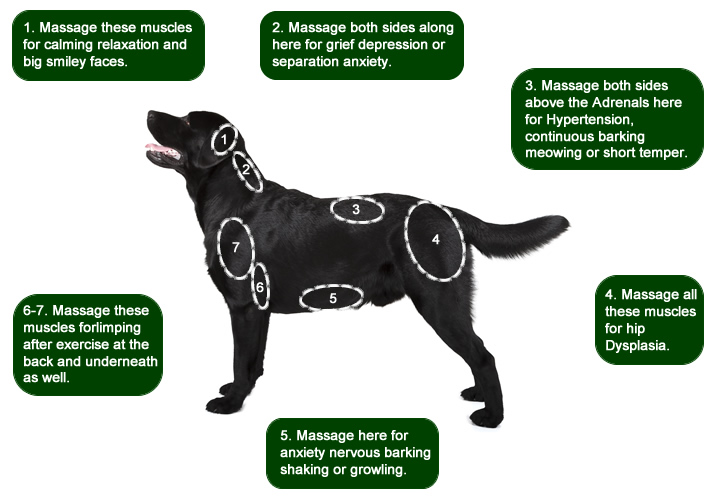
We all know that exercise can make us ache all over and the muscle tension involved can cause you to end up with a sore jaw, neck, back or stomach. Emotional stress can do the same thing, and ongoing tension in your muscles from stress triggers the bodies fight and flight responses into action which means you end up being flooded with all sorts of stimulating chemicals that won’t ever let you relax, calm down, and feel normal again, well, not until they are released that is!
The adrenals we mentioned earlier are situated on the back of the animal they fire up when animals are angry, upset, being chased, or feeling stressed. The belly region is where animals feel fear guilt and anxiety. (watch them slink along if they’ve done something naughty) The grief and emotional loss zones are between the shoulders both sides of the spine on the upper back.
 Forelegs on the outside of the shoulders plus up high under the ‘arm pit’ can get sore from running around and other areas that can get tense include the inside of the back legs and tension on top of the hips both sides of the spine, and outside of the rear flanks, which can contribute to hip dysplasia.
Forelegs on the outside of the shoulders plus up high under the ‘arm pit’ can get sore from running around and other areas that can get tense include the inside of the back legs and tension on top of the hips both sides of the spine, and outside of the rear flanks, which can contribute to hip dysplasia.
Cats worst points are deep in the neck muscles and in behind the ears.
A good start point in to begin on the neck both for cats and dogs. Use a gentle fingertip action to get them used to the massage and relaxed, then start working deeper and you move around their body. If you’re doing it right they will assume a submissive sitting position or roll onto their backs, cats start purring and dogs wag their tails non-stop.
Start out gently but expect that if you are going to do this properly you really will need to get quite firm as you move on. Good luck. I hope you enjoy a wonderful bit of interaction that can really make a difference in your animals life.
Oh and the big sad dog. Well after a few minutes of deep tissue between his shoulders and getting his adrenals released, plus a little tummy rub for his anxiety he was last seen wagging his tail furiously making friends with all and sundry and no longer hiding his head under the table.

Chris Toal
Managing Director Azolla Ltd.
Write a comment
Your Name:Your Comment: Note: HTML is not translated!
Rating: Bad Good
Enter the code in the box below:


